Dates for your Diary
We re-open on Thursday 6th January 2022
Museum opening times
The Museum is open to the public, free of charge:
Thursday* to Saturday 10am – 1pm
December 100 Club
This month’s prize numbers were drawn by Karen Jones & Gail Ashmead and the lucky winners are:-
No. 53 Liz Ewers £20
No. 88 Matthew Price £10
If you would like to join our 100 club and be in with a chance of winning, it costs just £1 a month. Ask at the museum for further details.
Christmas Raffle
The Christmas Raffle was drawn on 11th December and all winners have been notified. Anyone wanting a list of winning ticket numbers please contact museum or email me
The sweet jar winning number was 175
New - Members’ Loyalty card!
It’s that time of year again when we ask you to renew your membership. The fee is just £6 for standard membership and £25 for Vice Presidents and if you are a taxpayer, and have not already done so, please come in and sign a Gift Aid declaration so that we can claim another 25p for each pound given at no extra cost to you. All subscriptions received help with our running costs.
And this year, as a thank you, when you renew your membership you will receive a credit card sized ‘Loyalty Card’ entitling you to one free hot drink in our café every month of the year starting this month. The cards are ready and waiting, so don’t delay, renew today!

Christmas Fayre Success
Our Christmas Fayre last month went even better than hoped and we made over £600 which will all help with the museum’s running costs. Thank you to everyone who donated items and thank you to everyone who attended including, of course, our volunteers who made it all possible.
January
Where did January get its name? It comes from the Latin word Januarius after the Roman God Janus. Janus was the god of beginnings and transitions and is depicted as a two-faced head – a god who looks both forward and back and so it is appropriate for what we now consider to be the first month of the year. The two-faced head of Janus was often to be found above gateways and doorways.
Lacock
Are you a fan of Harry Potter? No? Then maybe Downton Abbey is more to your liking? Whichever your preference, you might like to visit the village of Lacock…
Lacock (pronounced Lay-cock) is a quaint little village near Chippenham in Wiltshire. The village is entirely owned by The National Trust and everyone living there rents their home from the Trust.
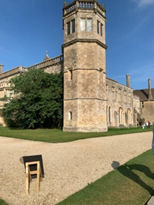 Harry Potter and Downton Abbey are just two of several productions that have had scenes filmed in the village. Others include Pride & Prejudice (1995), Moll Flanders (1996) and Cranford (2007)
Harry Potter and Downton Abbey are just two of several productions that have had scenes filmed in the village. Others include Pride & Prejudice (1995), Moll Flanders (1996) and Cranford (2007)
Harry Potter fans will be interested to hear that there are quite a few scenes that were filmed in this village. Central to the village is Lacock Abbey which has been the setting for inner parts of Hogwarts castle in the first two of the Harry Potter films.
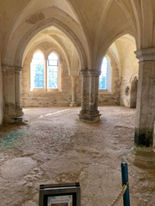 The Abbey cloister, pictured here, will no doubt be recognized by Harry Potter fans as the room at Hogwarts in the first film, Harry Potter & the Philosopher’s Stone (2001) where Harry finds the magic mirror that allows him to see his ‘heart’s desire’; in his case, his dead parents.
The Abbey cloister, pictured here, will no doubt be recognized by Harry Potter fans as the room at Hogwarts in the first film, Harry Potter & the Philosopher’s Stone (2001) where Harry finds the magic mirror that allows him to see his ‘heart’s desire’; in his case, his dead parents.
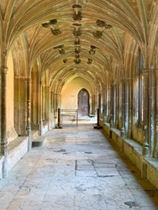 Likewise this photo of a long corridor will be instantly recognized by fans for the very memorable scene (and one of my favourites) in the second film, The Chamber of Secrets (2002), where Lucius Malfoy is tricked into giving a sock to his slave-elf Dobby and therefore setting himfree. More recently Lacock Abbey stood in for Hogwarts castle again in the Fantastic Beasts; The Crimes of Grindelwald (2018).
Likewise this photo of a long corridor will be instantly recognized by fans for the very memorable scene (and one of my favourites) in the second film, The Chamber of Secrets (2002), where Lucius Malfoy is tricked into giving a sock to his slave-elf Dobby and therefore setting himfree. More recently Lacock Abbey stood in for Hogwarts castle again in the Fantastic Beasts; The Crimes of Grindelwald (2018).
The village High Street, pictured below, has also been used as a film location; it was used for Horace Slughorn’s house in the 2009 film Harry Potter and the Half-Blood Prince as well as the royal parade in the 2019 film Downton Abbey.
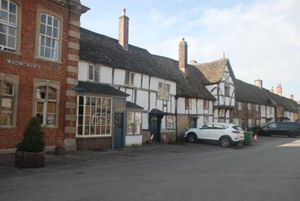
Easily ‘do-able’ as a day trip, Lacock offers a visitor reception, car parking, toilets and a National Trust tea-room. So for a pleasant day out it is well worth a visit, especially for all Harry Potter fans!
For more information on Lacock click here
All photos used here courtesy of my sister and brother-in-law who visited Lacock in the summer of 2021.
Sally Murphy
To all our readers have a very happy and healthy New Year!
The Dog Stone - An Unusual Memorial
In the December edition of the Newsletter I referred to a history walk our late Curator, Don Bearcroft, had led many years ago, the destination being The Dog Stone. As a keen hill walker it is a memorial I have visited a number of times but for those of you who are less keen on tramping uphill and over moorland and haven't seen this unusual memorial, I thought you might like to know a little more about it.
This memorial is to be found on Coity Mountain above the southern part of Blaenavon although is also readily accessible from Abertillery by walking up over the mountain from Cwmtillery. The iron memorial – the fact that it is made of iron is itself quite unusual - was erected to the memory of 'Carlo'. Carlo was a dog who belonged to Henry Kennard whose family were closely involved in the operation of the Blaenavon Company Ironworks during the mid 19th century, Henry being one of its directors for a time. The dog was accidentally shot during a grouse shooting party organised by the company on the mountain in 1864. Henry Kennard arranged for the dog to be buried where he had died and in order to ensure that the spot was remembered for the future, he arranged for a cast iron memorial to be erected. It still stands to this day and says "In memory of CARLO, a celebrated setter, the property of H M Kennard Esq, Crumlin Hall, accidentally shot August 12th 1864".
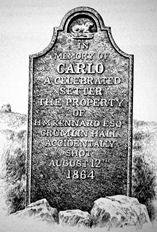 The memorial is a Grade II listed 'building' and was awarded this designation in 2010 in recognition of its special architectural and historic interest as a good and unusual example of a cast iron memorial slab displaying clear craftsmanship and having a considerable connection to regional social and economic history. It indirectly reflects the importance of the iron industry and the Kennard family in the history of Blaenavon, a town at the forefront of the industrial revolution.
The memorial is a Grade II listed 'building' and was awarded this designation in 2010 in recognition of its special architectural and historic interest as a good and unusual example of a cast iron memorial slab displaying clear craftsmanship and having a considerable connection to regional social and economic history. It indirectly reflects the importance of the iron industry and the Kennard family in the history of Blaenavon, a town at the forefront of the industrial revolution.
The mansion at Blaenavon, known locally as Ty Mawr - the big house – was built in association with the ironworks and when the Kennard family became involved in the ironworks, they also took over use of Ty Mawr. Kennard senior and his sons would stay there when on business in Blaenavon and during the grouse hunting season in the summer. Indeed, the house was extended in 1839 in order to increase its accommodation for shooting parties. The Kenards hosted some illustrious guests including European nobility as well as members of the local gentry. It is reported that in August 1866, over 100 grouse were shot in one day alone. It seems that the Kennards were a family of dog lovers as two gravestones can be found in the grounds there, erected over the graves of two family dogs known as 'Billy' and 'Bones'.
The Kennard family, including engineers H M and T W Kennard, were responsible for the construction of Crumlin Viaduct; the family home of at Crumlin Hall later became the Crumlin Mining and Technical College.
It's a lovely walk to the Dog Stone whether you go from Blaenavon or Abertillery and if you pick a clear day the panoramic views are superb.
The memorial is very difficult to photograph
successfully and so I am grateful to Chris Barber for kindly allowing us to reproduce the illustration by Michael Blackmore, from Chris's book 'Exploring Blaenavon Industrial Landscape World Heritage Site' published in 2002.
Jen Price
This article was put together using a variety of sources on the internet.
Christmas Sunday
Hopefully all our readers had a good Christmas last month but can you answer this question - when was Christmas Day not followed by Boxing Day? Answer, whenever Christmas Day fell on a Saturday…!
Until 1974 Britain was still ruled according to the Sunday Observance Act of 1780 which made it illegal to open a shop on a Sunday or even play football so Boxing Day, a big day in the sporting calendar and the day when sales traditionally began, was never on a Sunday. Each time Christmas Day fell on a Saturday (like the one we’ve just had) the Sunday was always known as ‘Christmas Sunday’ with Boxing Day, being on the Monday. The first football league match ever to be played on a Sunday was on 20th January 1974 when Millwall beat Fulham and twenty years later, in 1994 laws around Sunday trading were also relaxed and the tradition of ‘Christmas Sunday’ died out, with it last observed in 1993.
Hidden Gems
I daresay you all have your own 'hidden gem' of a spot in Abertillery but Cwmtillery Lakes come top of my list. I'm writing this because recently someone asked me if I knew Cwmtillery Lakes (I no longer live in Abertillery) and went on to say how wonderful they were. I certainly do know Cwmtillery Lakes and they are a picturesque sight today but they weren't always like that or, to be more precise, the lower lake wasn't always a pretty sight.
The top lake is Cwmtillery Reservoir, built in the latter years of the 19th century, and subsequently extended, to provide a badly needed clean water supply as Abertillery's industries and population grew. For information on the reservoir (and much more) I highly recommend this website
I learned there that the first reservoir leaked badly and was beset by problems which were eventually solved. The demand for clean water also led to the construction of the Grwyne Fawr reservoir in the Black Mountains and it is incredible to think that the water runs from that reservoir (opened in 1928) all the way to Abertillery via a gravity fed pipeline. What a wonderful feat of engineering. I don't know if the reservoir at Cwmtillery still functions as a public water supply for Abertillery but it certainly supplies a good spot for fly fishing and is home to a local angling club. In my memory the top lake – the reservoir – was always picturesque, somewhere to collect bluebells in the wood and to have picnics.
The bottom lake was altogether different. It was built as a feeder pond for Cwmtillery Colliery which opened in the mid-19th century. I remember the lower lake from my childhood as dirty and forbidding, the water soiled by waste from the tip on the mountainside above, or presumably from the buckets which carried the waste up the mountain for tipping. The colliery closed in 1982 and Cwmtillery and its lower lake have since been transformed with the removal of the pit head buildings and gear and the transformation of the lower lake into the beautiful lake and memorial garden which give such pleasure to the many many people now who walk there. Thanks must go to the local community organisation CLEAN who work so hard to keep the area litter-free and in good order (I assume this group is still functioning but not being a resident of Abertillery now I'm not sure; I hope so...)
The whole of the top of the Cwmtillery valley is also a good spot for bird watching and if you dip into a book called 'Birdwatching Walks in Gwent' you will see a list of the many birds to be seen there as well as details of the walk around the lake, although that will already be familiar to most of our readers.
Well, that's my hidden gem. I know it isn't hidden to those who live locally but it is certainly a hidden gem for those who don't.
Jen Price
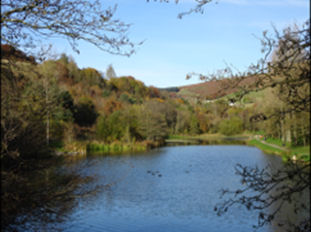
Editor’s Note
In early September 2021 a community café opened at the lakes. Called ‘Caffi Tyleri’, it is open Tuesday to Saturday 10am – 3pm and is run by a team of young local people. If you enjoy walking, every Tuesday at 10.30 is a guided two hour walk led by local man, Steve Davies. It starts and ends at the café so if you fancy a nice winter ramble followed by a some warming soup and a nice cup of coffee or tea then you know where to go.
For more information use the links below:-
CaffiTyleri Facebook
Steves Tuesday Treks
Top Of Page
